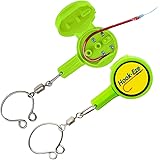Fly fishing is a popular pastime that allows you to enjoy nature while challenging your skills and patience. If you are new to fly fishing, trout fishing can be an excellent place to start. In this guide, we will cover everything from choosing the right equipment to mastering basic casting techniques and catching trophy-sized trout.

Introduction to Trout Fishing
Trout are freshwater fish that thrive in cold streams, rivers, and lakes. They are known for their aggressive feeding habits and their willingness to take on bait or lure. For beginners, trout fishing offers a unique challenge because they require precise presentation and careful observation of their behavior. With practice, you can become an expert at catching these elusive creatures.
Choosing the Right Equipment for Fly Fishing

When it comes to fly fishing gear, there are several essential pieces of equipment that you need to have. These include a rod, reel, line, leader, tippet, and flies. You want to choose high-quality gear that is durable enough to withstand the rigors of fishing but lightweight enough to cast easily. Look for rods made of graphite or fiberglass, as well as reels with smooth drag systems and large arbors. Your line should match the weight of your rod and the size of the fish you plan to target. Leaders and tippets come in various strengths and lengths, so make sure to choose ones that suit your needs. Finally, don’t forget about the flies themselves – these imitate insects that trout love to eat, such as mayflies, caddis, and stoneflies. Choose a variety of patterns and sizes to ensure success on the water.
Understanding Trout Behavior and Habitat
To successfully catch trout, you need to understand their behavior and habitat. Trout are most active during dawn and dusk when the sun isn’t too bright. During the day, they tend to hide under rocks or other structures to avoid predators. When selecting a spot to fish, look for areas where the current is strongest, as trout prefer fast-moving water. Also, pay attention to the weather conditions, as changes in temperature or barometric pressure can affect their feeding habits.
Mastering Basic Casting Techniques
Casting is one of the most critical aspects of fly fishing. To get started, hold your rod in front of you with both hands, keeping your thumbs close together. Push the line forward with your dominant hand until it stops, then release the line by pulling back with your non-dominant hand. Practice this motion until you feel comfortable with it. Once you have the basics down, work on improving your accuracy and distance by practicing different types of casts like overhead, roll, and sidearm.
Tips for Catching Trophy-Sized Trout
If you’re looking to land some big trout, here are a few tips to help you out. First, focus on finding prime spots where larger fish tend to congregate, such as deep pools or undercut banks. Second, use bigger flies and heavier tackle to increase your chances of landing a monster. Third, try to stay hidden behind trees or rocks to avoid scaring off any potential bites. And finally, be patient and persistent – sometimes it takes hours or even days to hook into a trophy-sized trout. But with dedication and skill, anything is possible!































































